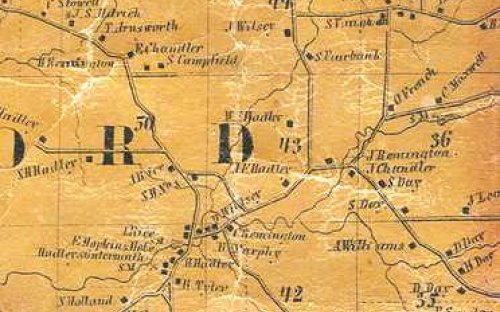This location is private property.
“The Old Remington Place” in the town of Ashford was a station on the Underground Railroad. Conductor Joseph Remington spent many years assisting run away slaves on the road to freedom.
Joseph Remington was born in 1792 in Vermont . He was married to Amanda Sacket. They moved to East Ashford, NY in about 1835. Migrating from his native Vermont with his family, Joseph bought a house there around 1839. The house was built in about 1830. The building became known as “The Old Remington Place” and became a stop or station on the Underground Railroad. It is not known when runaway slaves began to come through the door of the home. Nor is there any record or hint of how many fugitives found respite within the walls of this building.
Information about Remington’s involvement and the use of the home as a hiding place for those seeking freedom came to light due to the research of Joseph Remington’s great-granddaughter. Julia Pierce served as historian of Cattaraugus County in the 1950s era. During her tenure as a historian her interest in her great-grandfather and his activities piqued. Julia recalled stories her mother had shared with her in regards to Julia’s great-grandfather. She was told about slaves who were hidden in the house during daylight hours then how her great-grandfather Remington would help the slaves move north toward freedom by taking them to the next station once the skies were dark. He would feed these folks and give them a place to rest, allowing the a brief respite of comfort. They could enjoy the security briefly knowing someone was guarding their safety for at least a short period of time.
The oral history continues, relaying that the slaves came from the south at the Inn in Cadiz. Colorful stories told of slaves arriving in the dark of night, hurrying inside the home on Gooseneck Road to safe shelter. Some accounts insist the slaves were hidden in the loft while others tell of slaves stowed away in the basement. Those details will never be known for certain. Food and rest were provided and when deemed safe during darkened hours, horses were hitched to the wagon, slaves onboard under straw and/or blankets for their 10-12 mile journey to the next Underground Railroad station. The empty wagon would then hurry on home during the night hours hopefully seen by no one. It was stated by some story tellers that this was the last station in Cattaraugus County. This may be true if the next stop was in Arcade, or in Nichols Brook. However, many ‘switchbacks’ were utilized to throw off the path of the slave catchers. Those were the ruthless bounty hunters that were continually hunting runaways to capture and return south to their masters and a life of oppression while stashing money for doing so in their pockets.
Not all stations on the Underground Railroad have been identified. Therefore, it is difficult and/or possibly in error to claim the Remington House was the last stop in Cattaraugus County. Needless to say many fugitives were aided by Joseph Remington. We will never have an accurate accounting of the exact number. Remington died on October 3, 1867. The house Joseph Remington and his family lived in so many years ago on Gooseneck Road is still standing in the Town of Ashford.
Source: Pierce, Julia G., Cattaraugus County Historian, Allegany, NY: relaying oral history
Other sources based information reported on accounts from Julia Pierce. (Some of those retold accounts include: 1. Newspaper: Cattaraugus Star and Rushford Spectator, “County Historian Traces County’s Underground R.R., March 12, 1954.,
2. Newspaper: Buffalo Courier Express, Fess, Margaret. “House Near Riceville Once Used to Shelter Slaves, September 11, 1955.,
3. New York State Radio Bureau, New York State Commerce Department, Houses of History. Buckbinder, Barbara Ann, “A Station on the Underground Railway”. Week of June 16-22, 1963..
4. Lincoln Rochester Trust Company, Noontime News, WHEC, Sisson, Al. “New York House of History-Remington House.” June 17, 1963.
Information submitted by Sue M. Cross, Town of Mansfield Historian

